CENTRAL WISCONSIN ENVIRONMENTAL STATION CWES History
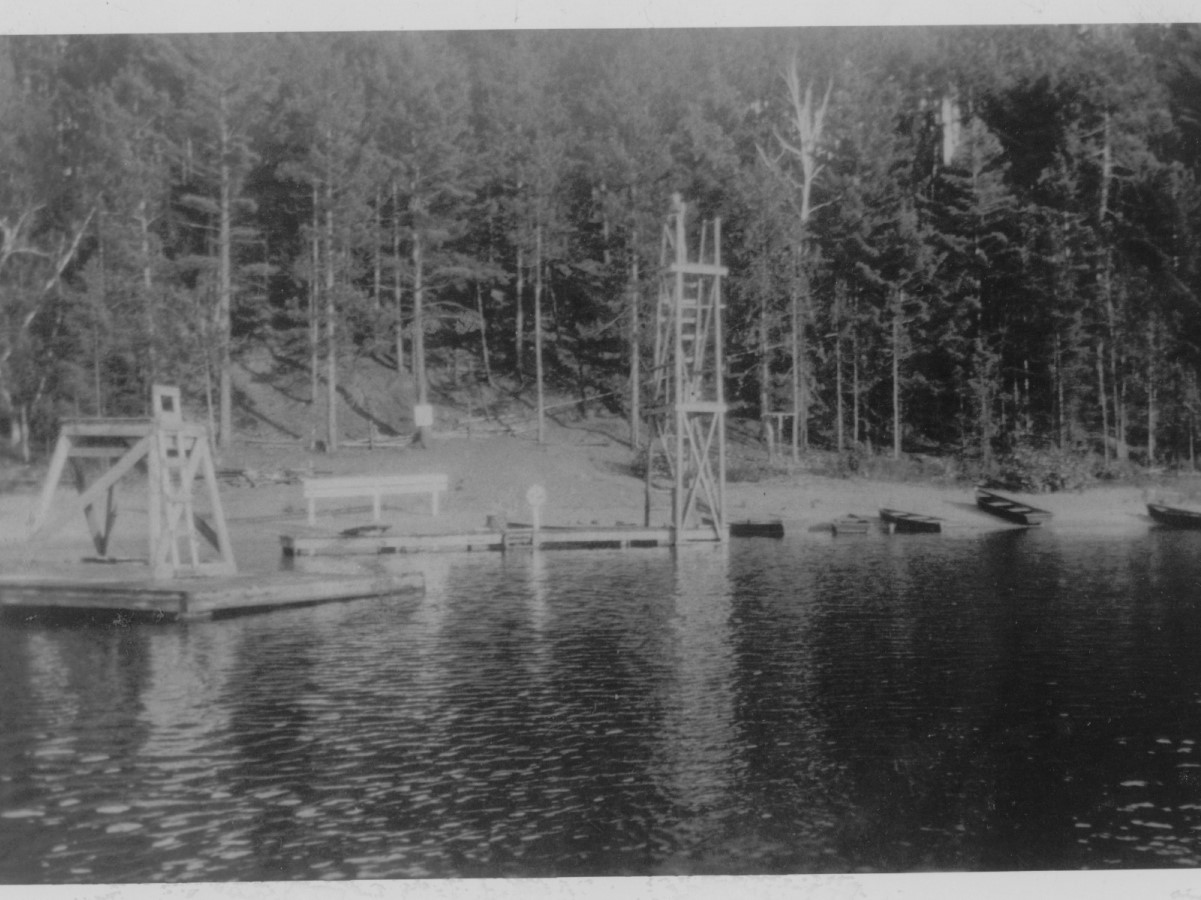 Waterfront 1928
Waterfront 1928
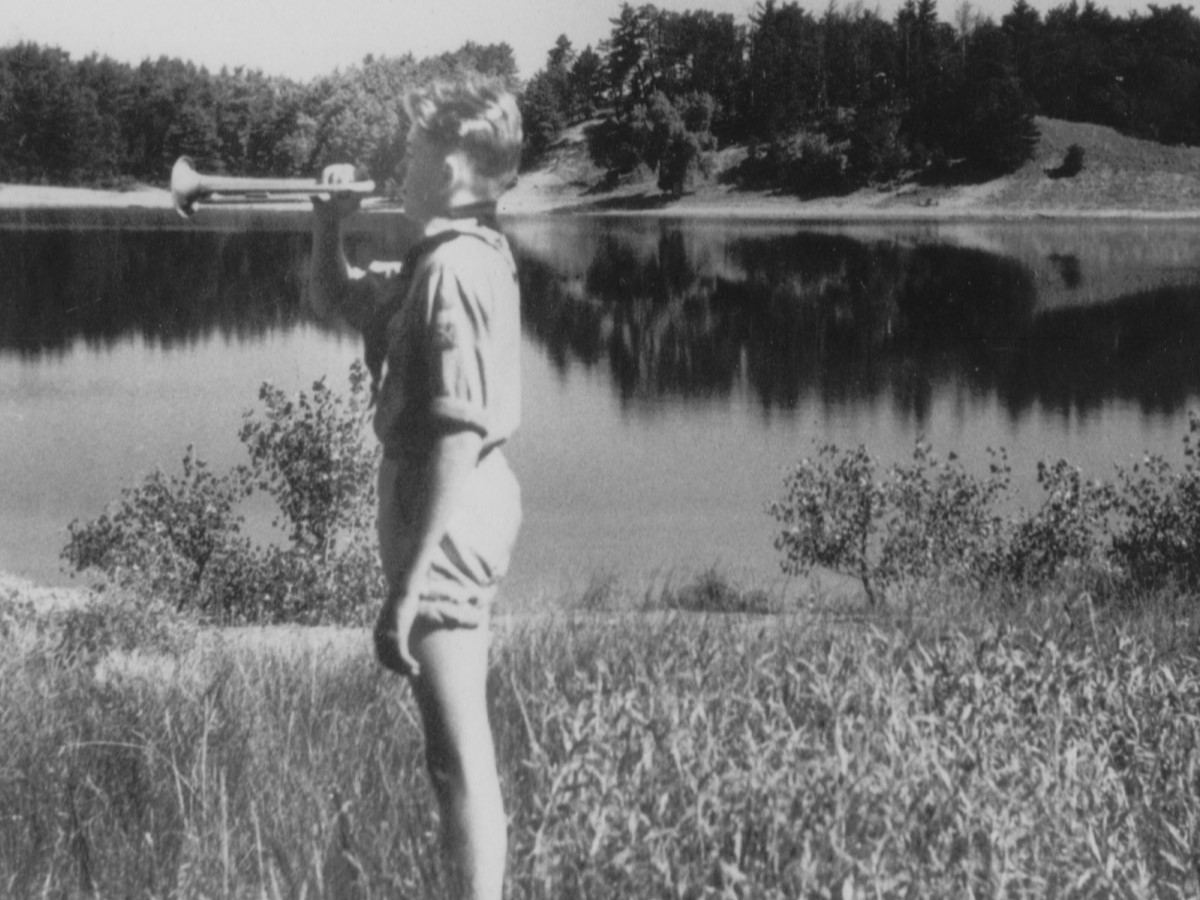 Bugler Don Colby – Arrowhead Hill in the background1938
Bugler Don Colby – Arrowhead Hill in the background1938
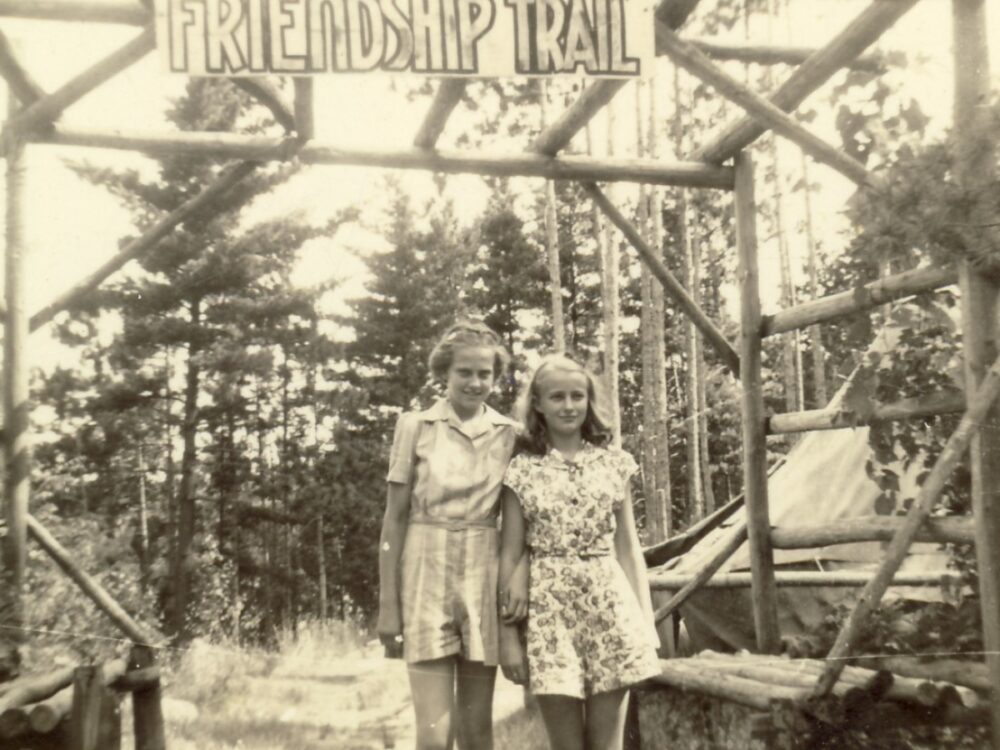 Camp Chickagami 1940 (Mary Bendfelt and Thera Kerr)
Camp Chickagami 1940 (Mary Bendfelt and Thera Kerr)
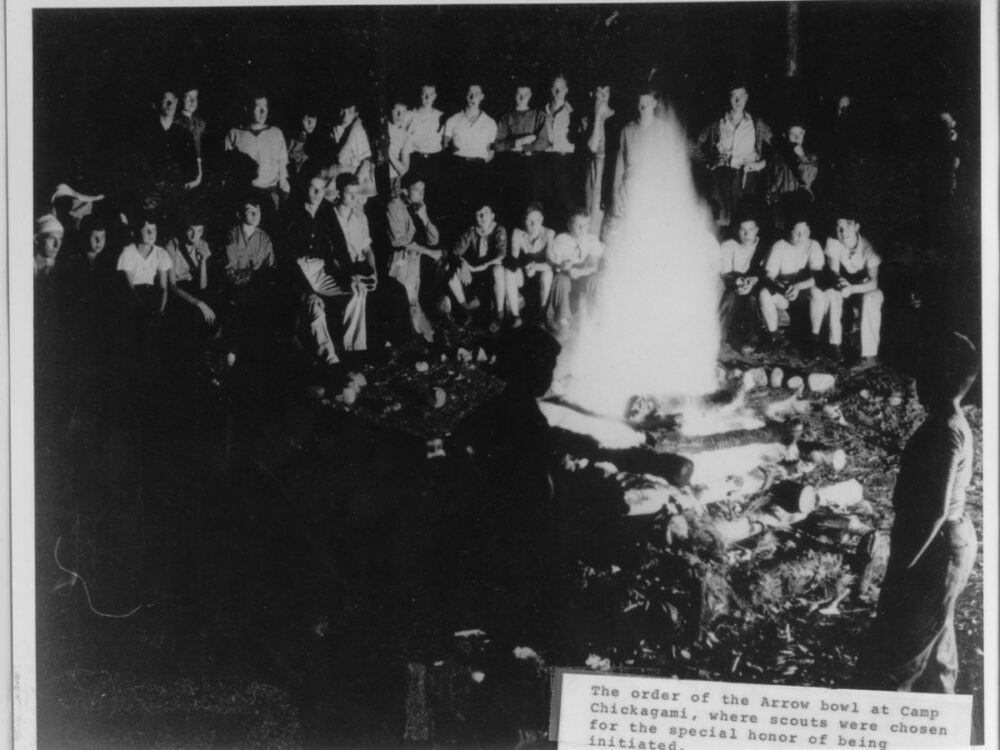 The Order of the arrow firebowl
The Order of the arrow firebowl
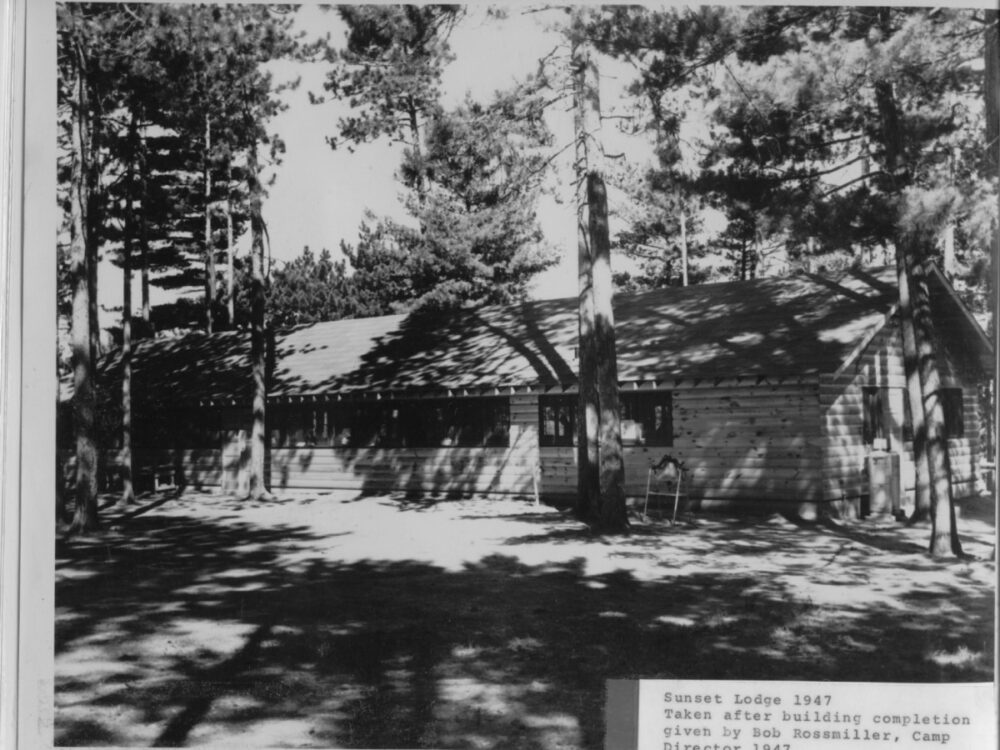 Original Sunset Lodge 1947
Original Sunset Lodge 1947
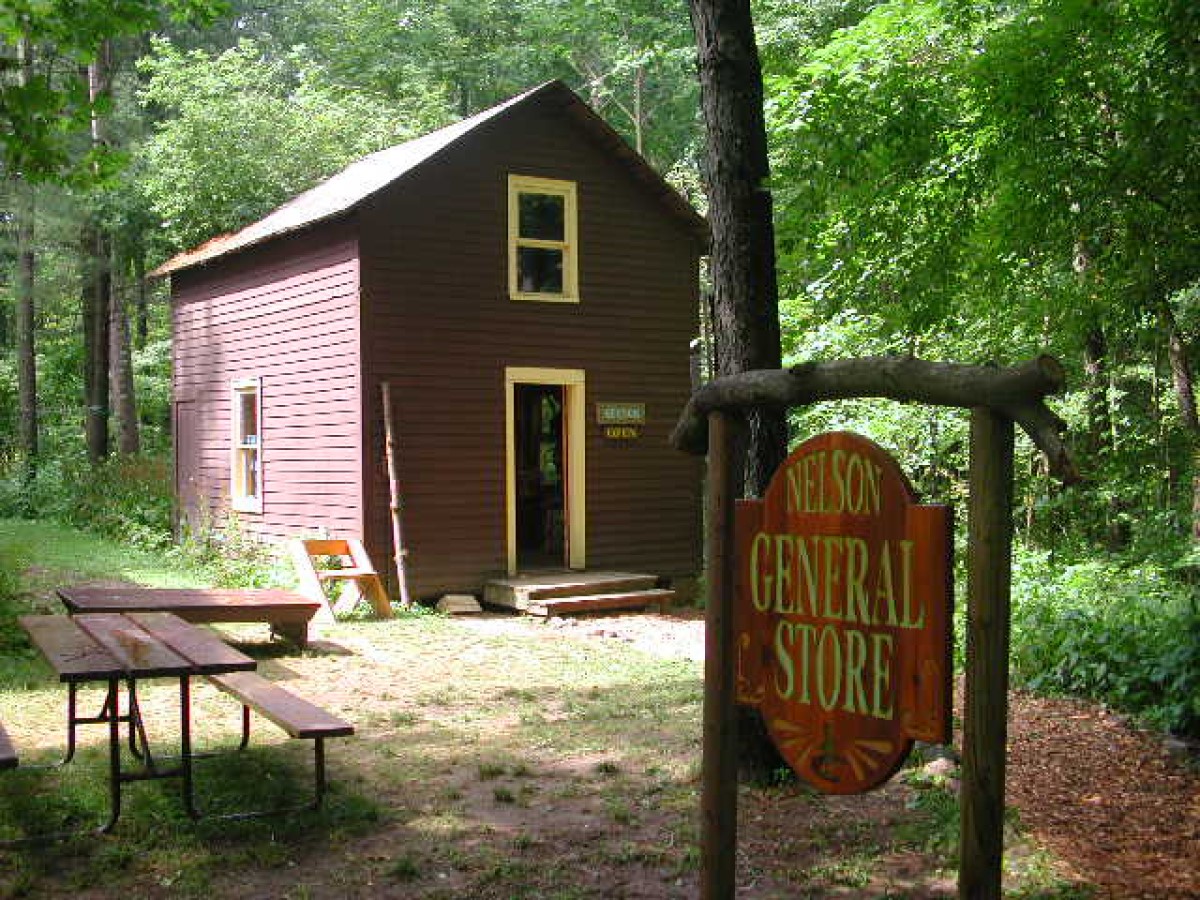 CWES General Store
CWES General Store
History of CWES
(Full history version here)
- 10,000 years ago, Glaciers created Sunset Lake, a kettle lake.
- About 800-1000 years before the present, Early Woodland Indians (a mound-building culture) inhabited this site as determined by arrowheads, pottery pieces, and mounds found on/around current CWES land. Other Native American peoples followed.
- 1850’s Logging operations reached central Wisconsin and changed the face of the land at Sunset Lake.
- 1921 Mark Nelson, a friend of local Boy Scouts, leases his land to the Samoset Council. Camp Chickagami was officially “born” just 11 years after the Boy Scout Movement began in England, although scouting activities here took place even earlier than 1921. The origin of the camp name is unknown.
- 1924 Clinton Copps donates a parcel of land at the foot of “Arrow Head Hill,” a hill on the north side of Sunset Lake that creates an arrowhead image in the lake due to its reflection in the water.
- 1928 The 1921 lease option is exercised, and Mark sells his “upper” 20 acres (7 acres of land and 13 of water) to the Boy Scouts. When the Boy Scouts aren’t using the land, the Girl Scouts are permitted to host camps, and this sharing of the land during summers has taken place for more than 45 years.
- 1937-1938 Cabins are constructed on the east and west camps. Cabin names include Delaware, Iroquois, Seminole, Ojibway, Mohican, Cheyenne, Sioux, Winnebago, Fox, Menominee, Cherokee, and Chippewa. Names later changed to tree names such as Maple, Oak, and Cherry.
- 1941 George Mead of Home Lumber Company buys the “lower” 20 acres of the Nelson property, logs it, and donates it to the Boy Scouts.
- 1945 Sometime before the summer of 1945, Mark Nelson’s cabin is moved from its original location on the southwest ridge overlooking the lake to its present position in the main CWES camp. The cabin later served as an office, a library, and a classroom until 1999, when it became the CWES General Store in memory of Mark and his profession around 1900 as the owner of the Benson’s Corners General Store, three miles southeast of Sunset Lake.
- 1947 Sunset Lodge was built. It includes a fireplace on the west end that Robert Worth later describes as a place where boys competed for the closest bunk bed during winter camp.
- 1948-1951 The Samoset Council concentrates its resources on the development of Camp Tesomas in Rhinelander, and a new Camp Chickagami Trust was created in 1951 to guide the future of the property as they began to look for other uses of the land. Also, around this time, Hiram Anderson donates 37 acres on the northwest corner of Sunset Lake. This land later becomes known as Raccoon Run Trail.
- 1955 Land around Arrow Head Hill is transferred from the Samoset Council to the Boy Scout Trust, established in 1951.
- 1956 Becker Lodge is constructed.
- 1965 Hiram Anderson donates 6.5 acres of land adjacent to the Clinton Copps land around Arrow Head Hill. By this time, the land holdings in the trust totaled nearly 125 acres.
- 1968 Hiram Anderson donates 80 acres of property on Severson (Budsberg) Lake, two lakes east of Sunset Lake, to the Wisconsin State University-Stevens Point Foundation, Inc. (later UWSP Foundation, Inc.). The land is subleased to the College of Natural Resources and used for educational purposes.
- 1974 Roland (Rollie) Martin (“Swift Hare” in the Order of the Arrow and a resident of Amherst Junction) leads the last summer camp for Boy Scouts at Camp Chickagami. Hiram Anderson, local attorney and Trustee of Camp Chickagami, approaches Lee Sherman Dreyfus, Chancellor of UWSP, to discuss the possibility of using the property for educational programs.
- 1975 The Trustees of Camp Chickagami lease the camp property to the UWSP Foundation which in turn sub-leases it to the College of Natural Resources (CNR) for operation as the Central Wisconsin Environmental Center (CWEC). (Name later changes to Central Wisconsin Environmental Station (CWES) because of the state requirements for being named a “center.”) The mission of the CWES is to “provide a foundation for appreciation and understanding of our environment and to develop the skills and attitudes needed to deal with present and future environmental problems.”
- 1976 CWES Residence building is built.
- 1979 Although the new school curriculum had been piloted previously, the official kick-off of the new modules takes place this fall. Another boost to the school programs includes the construction of the Elda Bark Walker Lodge, a winterized school dormitory, allowing CWES to host year-round residential programs at. The dinner bell atop Sunset Lodge is dedicated in memory of Don G. Walker, Elda Bark Walker’s second husband.
- 1980 Anderson Lodge, named for Hiram Anderson, is constructed. It becomes the Boy Scouts’ new winter camping facility as they continue to have first rights to CWES/Camp Chickagami for weekends in October through April as part of the 1975 trust agreement with UWSP.
- 1983 A lease arrangement is developed with the North New Hope Lutheran Church. It allows CWES the opportunity to use church lands adjacent to CWES for educational purposes. This includes the Minister Lake property where the pond study takes place and the land on which the challenge course is later created at CWES.
- 1984 Sunset Lodge expanded to create the current office area on the east end.
- 1985 CWES celebrates its 10th Anniversary with a kick-off of the Adopt-a-Log Program to fund support for the new construction of cabins to replace old Boy Scout cabins on the east property. Lee Sherman Dreyfus gets it all started by shaving the first log.
- 1990 CWES Challenge Course is developed.
- 1991 Family camps are popular.
- 1995 CWES celebrates its 20th Birthday. CWES is given the “Excellence in Environmental Education” Award from the Wisconsin Association for Environmental Education.
- 1996 New east bathhouse construction is completed. This facility serves the five Scandinavian-style log cabins (completed through the Adopt-a-Log program) as well as Anderson Lodge.
- 1998 The Wisconsin Future Farmers of America organization awards CWES the “Distinguished Service Award.”
- 1999 A vision of a new education center begins to take shape. CWES adopts a new vision statement and updates its mission statement. The mission of CWES is to “foster in adults and youth the appreciation, understanding, skill development, and motivation needed to help them build a sustainable balance between environment, economy, and community.”
- 2000 The development of a new statewide middle school curriculum, “Wisconsin Forestree,” is completed. CWES adopts a new logo, and its image is updated for the new century. A major upgrade is completed on Walker Lodge, and a new dock system updates the waterfront on Sunset Lake.
- 2001 Almost 100 students at CWES took shelter from storms and later assisted in storm damage clean-up. The greenhouse and hoop house was destroyed by white pines, and the chicken coop was also damaged. A tree fell on a lodge directly above a bunk.
- 2002 The Changing of the Land: A Wisconsin Forest History Unit was developed in 2002 under a Wisconsin Environmental Education Board (WEEB) grant at the Central Wisconsin Environmental Station.
- 2005 Groundbreaking ceremony is held, and plans revealed for Sunset Lodge renovation.
- 2007 Sunset Lodge is damaged by an electrical fire on October 17, 2007.
- 2011 UW-Stevens Point rents land from Ross Dick in the Town of New Hope to grow and harvest food to be used in the food service program at CWES. There is also a fenced-off area for chickens for egg production.
- 2012 CWES secured a significant three-year challenge grant from the Margaret A. Cargill Foundation (MAC) to offer camp-themed after-school programming for up to 200 central Wisconsin youths per year.
- 2013 The Tomorrow River Community Charter School (TRCCS) opens the first Waldorf-inspired Wisconsin public charter school at CWES. Sixty-two students were enrolled for Fall 2013 in grades pre-kindergarten through grade 6. In 2014, TRCCS received the U.S. Department of Education Green Ribbon Schools Award.
- 2013 Former small cabins used by boy scouts, then summer camp staff quarters, are renovated to be used by the Charter school. The old maintenance building is renovated to Sunrise Classroom.
- 2013 Installation of a new entrance sign made by UW-Stevens Point Schmeeckle Reserve sign-making masters with a sign base by Dulak Masonry.
- 2014 CWES received an on-site visit from the American Camp Association and received accreditation.
- 2014 Water bottle filling stations are installed in Sunset and Walker lodges to save plastic water bottle usage
- 2015 Construction is completed for the Byron and Margaret Shaw cabin and a new bathhouse to accommodate increased usage by summer campers, school groups, and weekend education retreat groups.
- 2016 CWES is recognized by the Bill Cook Chapter of the Izaak Walton League as the “Outstanding Conservationist” of 2016.
- 2017 Mid-State Technical College students install solar panels with the help of TRCCS students.
- 2017 Hoop house installation.
- 2018 Ron and Patty Adamski outdoor fireplace dedication
- 2019 Sunset Lodge is dedicated to Rick Wilke as a tribute to his life, career, and contributions to the university and environmental education.
- 2019 Dutton cabin dedication
- 2020 The University of Wisconsin-Stevens Point takes precautions to reduce the risk of spreading the coronavirus (COVID-19). CWES cancels week-long residential camps, adventure trips, and day camps for the summer.
- 2022 A grant from the Natural Resources Foundation “Go Outside Fund” allowed sixth graders from McKinley Elementary of the Stevens Point School District to experience a field trip to CWES that enhanced their regular science and social studies curricula.
- 2023 100% of food waste is collected and sent to the university’s recycling and reuse center to be composted and used for fertilizer in flower beds and on practice fields.